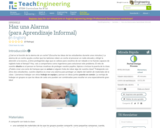
Los estudiantes diseñan y construyen un sistema de alarmas para proteger algo suyo cuando no están presentes.
- Subject:
- Applied Science
- Engineering
- Material Type:
- Activity/Lab
- Provider:
- TeachEngineering
- Provider Set:
- Sprinkles
- Date Added:
- 05/03/2016

Los estudiantes diseñan y construyen un sistema de alarmas para proteger algo suyo cuando no están presentes.
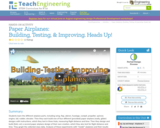
The purpose of this activity is to demonstrate some of the different parts of an airplane through the construction of a paper airplane. Students will build several different kinds of paper airplanes in order to figure out what makes an airplane fly and what can be changed to influence the flying characteristics of an airplane.

In this video segment adapted from United Tribes Technical College, meet Native Americans who are concerned about climate change and believe that action today can help future generations once again live in harmony with Earth.
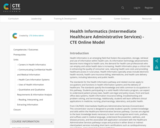
Health Informatics is an emerging field that fosters the acquisition, storage, retrieval and use of information within health care. As information technology advancements become more integral to health care, the demand for health care professionals who can employ and utilize health data is increasing. Health Informatics plays a critical role in enhancing the quality of consumer care, reducing health care costs and providing healthcare access in rural areas. Health Informatics specialty areas include electronic health records, health care insurance billing, telemedicine, and health care delivery systems, including laboratory and public health.The standards for the Health Informatics pathway and related courses apply to occupations and functions in health information systems and the delivery of healthcare. The standards specify the knowledge and skills common to occupations in this pathway. Students participating in a solid Health Informatics program, can expect to understand patient privacy laws, health care legal and policy issues, front and back office data systems, health information insurance billing, troubleshooting and problem solving, and terminology. Additionally, students will learn different clinical applications in medicine, nursing, pharmacology, laboratory, and public health.

Although mom controls the oxygen source, the fetus has a couple of clever tricks to get the most oxygen possible! Rishi is a pediatric infectious disease physician and works at Khan Academy.
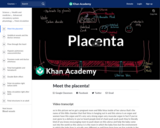
Learn how the needs of the fetus are met by the placenta, which is a special organ that belongs to both the mother and the fetus! Rishi is a pediatric infectious disease physician and works at Khan Academy.
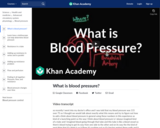
Using the stethoscope to check blood pressure is a technique thatŐs been used for >100 years! Blood pressure is one of the major vital signs frequently measured by health care workers, and it tells us a lot about our blood circulation. Learn what blood pressure is, how it relates to resistance in a tube, why it is necessary to get oxygen to your cells, and how it can change as you age. WeŐll finally put it all together by relating pressure, flow, and resistance in one awesome equation!
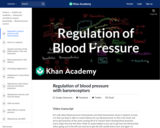
The human body enjoys stability. For example, if your blood pressure changes, the body puts a couple of brilliant systems into motion in order to respond and bring your blood pressure back to normal. There are some quick responses using nerves and some slower responses using hormones. The system using hormones is sometimes called the renin-angiotensin-aldosterone-system (RAAS), which is the main system in the body for controlling blood pressure. When your blood pressure drops too low or gets too high, your kidneys, liver, and pituitary gland (part of your brain) talk to each other to solve the problem. They do this without you even noticing! Learn how the body knows when the blood pressure has changed, and how hormones like angiotensin 2, aldosterone, and ADH help return blood pressure to back to normal.
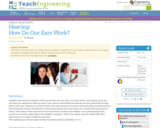
Students learn about the anatomy of the ear and how the ears work as a sound sensor. Ear anatomy parts and structures are explained in detail, as well as how sound is transmitted mechanically and then electrically through them to the brain. Students use LEGO® robots with sound sensors to measure sound intensities, learning how the NXT brick (computer) converts the intensity of sound measured by the sensor input into a number that transmits to a screen. They build on their experiences from the previous activities and establish a rich understanding of the sound sensor and its relationship to the TaskBot's computer.
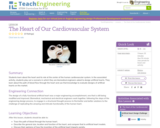
Students learn about the heart and its role at the center of the human cardiovascular system. In the associated activity, students play out a scenario in which they are biomedical engineers asked to design artificial hearts. They learn about the path of blood flow through the heart and use that knowledge to evaluate designs of artificial hearts on the market.
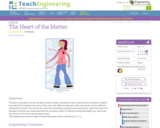
This lesson describes how the circulatory system works, including the heart, blood vessels and blood. Students learn about the chambers and valves of the heart, the difference between veins and arteries, and the different components of blood. This lesson also covers the technology engineers have developed to repair the heart if it is damaged. Students also understand how the circulatory system is affected during spaceflight (e.g., astronauts lose muscle in their heart during space travel).

Students learn about the form and function of the human heart through lecture, research and dissection. They brainstorm ideas that pertain to various heart conditions and organize these ideas into categories that help them research possible solutions. An expert in the field of cardiac valve research was interviewed for this lesson and shares his ideas with the class. Students conclude by researching various possible heart defects.
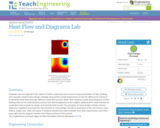
Students' eyes are opened to the value of creative, expressive and succinct visual presentation of data, findings and concepts. Student pairs design, redesign and perform simple experiments to test the differences in thermal conductivity (heat flow) through different media (foil and thin steel). Then students create visual diagrams of their findings that can be understood by anyone with little background on the subject, applying their newly learned art vocabulary and concepts to clearly communicate their results. The principles of visual design include contrast, alignment, repetition and proximity; the elements of visual design include an awareness of the use of lines, color, texture, shape, size, value and space. If students already have data available from other experiments, have them jump right into the diagram creation and critique portions of the activity.
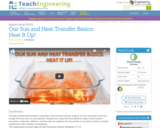
Through a teacher demonstration using water, heat and food coloring, students see how convection moves the energy of the Sun from its core outwards. Students learn about the three different modes of heat transfer (convection, conduction, radiation) and how they are related to the Sun and life on our planet.
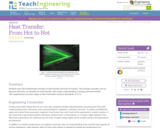
Students learn the fundamental concepts of heat transfer and heat of reaction. This includes concepts such as physical chemistry, an equation for heat transfer, and a basic understanding of energy and heat transfer.
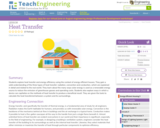
Students explore heat transfer and energy efficiency using the context of energy efficient houses. They gain a solid understanding of the three types of heat transfer: radiation, convection and conduction, which are explained in detail and related to the real world. They learn about the many ways solar energy is used as a renewable energy source to reduce the emission of greenhouse gasses and operating costs. Students also explore ways in which a device can capitalize on the methods of heat transfer to produce a beneficial result. They are given the tools to calculate the heat transferred between a system and its surroundings.
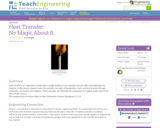
Heat transfer is an important concept that is a part of everyday life yet often misunderstood by students. In this lesson, students learn the scientific concepts of temperature, heat and the transfer of heat through conduction, convection and radiation. These scientific concepts are illustrated by comparison to magical spells used in the Harry Potter stories.
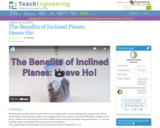
Students discover the scientific basis for the use of inclined planes. Using a spring scale, a bag of rocks and an inclined plane, student groups explore how dragging objects up a slope is easier than lifting them straight up into the air. Also, students are introduced to the scientific method and basic principles of experimentation. To conclude, students imagine and design their own uses for inclined planes.

Students learn about weight and drag forces by making paper helicopters and measuring how adding more weight affects the time it takes for the helicopters to fall to the ground.

Meet savvy scientist and inventor Hedy Lamarr, also known for her career as a glamorous international movie star. Dubbed "The Most Beautiful Woman in the World," Hedy actually preferred spending time creating inventions in her workshop to strutting down the red carpet. Hedy co-invented the technology known as frequency hopping, which turned out to be one of the most important scientific breakthroughs of the twentieth century! Today's cell phone, computers, and other electronic devices would be more vulnerable to hacking without the groundbreaking system discovered by a world-famous actress and gifted inventor. The resource includes a lesson plan/book card, a design challenge, and copy of a design thinking journal that provide guidance on using the book to inspire students' curiosity for design thinking. Maker Challenge: Create small groups. Pass out one of the challenges listed in the lesson plan/book card to each group for them to come up with an invention that will solve the problem at hand.